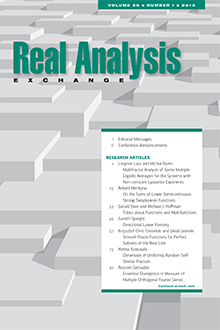Abstract
A function $f: {\mathbb R} \rightarrow {\mathbb R}$ is vertically [horizontally] rigid for $C \subseteq (0,\infty)$ if $graph(cf)$ [$graph(f(c\;\cdot))$] is isometric with $graph(f)$ for every $c \in C$. $f$ is vertically [horizontally] rigid if this applies to $C= (0,\infty)$. Balka and Elekes have shown that a continuous function $f$ vertically rigid for an uncountable set $C$ must be of the form $f(x)=px+q$ or $f(x)=pe^{qx}+r$, in this way confirming Jancović's conjecture saying that a continuous $f$ is vertically rigid if and only if it is of one of these forms. We prove that their theorem actually applies to every $C \subseteq (0,\infty)$ generating a dense subgroup of $((0,\infty),\cdot)$, but not to any smaller $C$. A continuous $f$ is shown to be horizontally rigid if and only if it is of the form $f(x)=px+q$. In fact, $f$ is already of that kind if it is horizontally rigid for some $C$ with $card(C \cap ((0,\infty) \setminus \{1\})) \ge 2$
Citation
Christian Richter. "Continuous Rigid Functions." Real Anal. Exchange 35 (2) 343 - 354, 2009/2010.
Information





